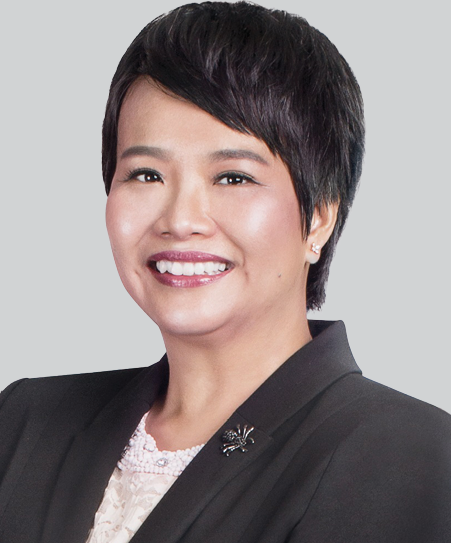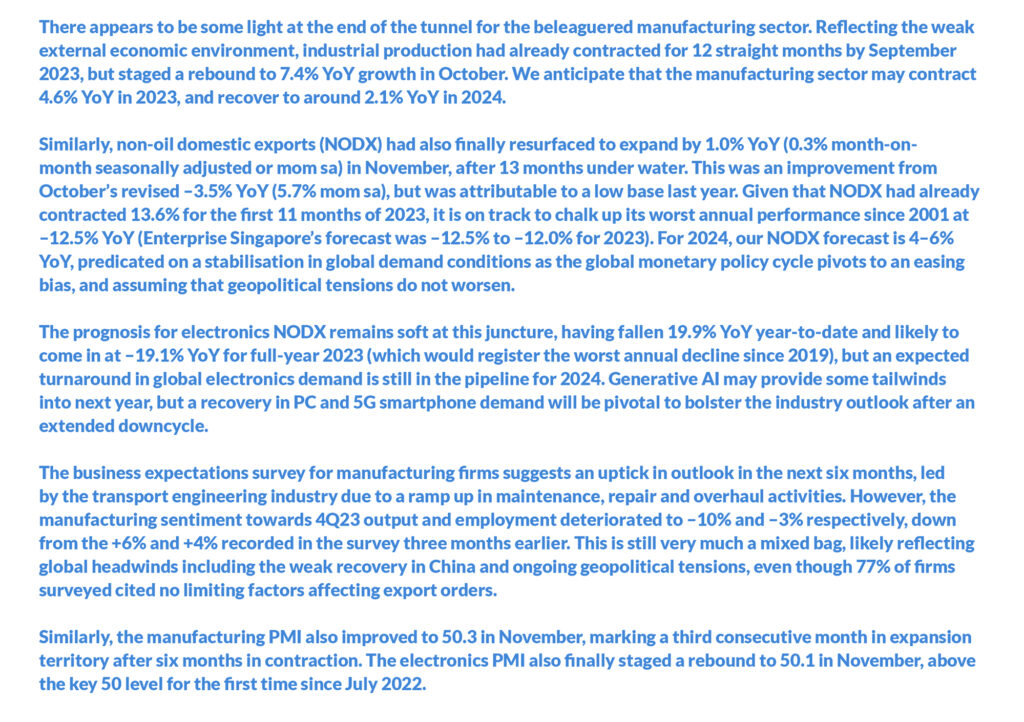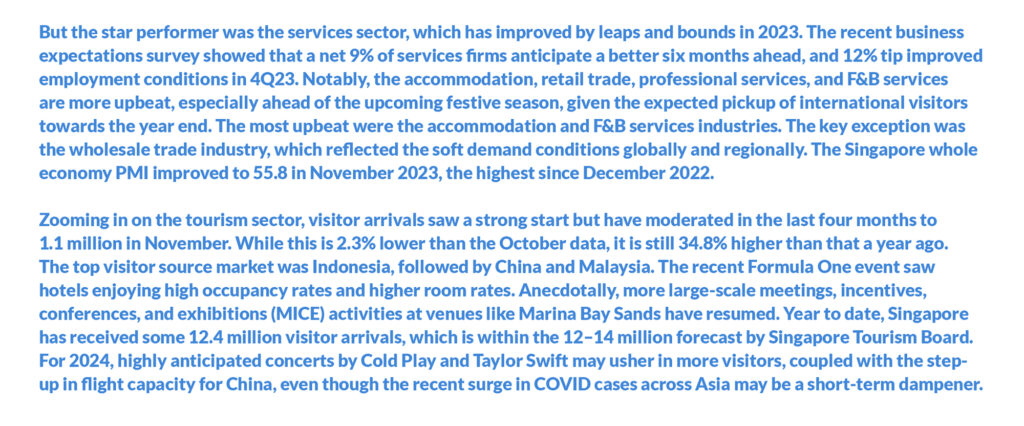

TAKEAWAYS
What would 2024 bring? As I write this article in December, I take a look back at the past 11 months or so, and also ahead – to try to see what the future may hold for us here in Singapore.
The Singapore economy avoided a technical recession in 2023, but GDP growth remained muted at 0.7% year-on-year (YoY) for the first three quarters of 2023. This is a slowdown from the 3.0% YoY growth registered for full-year 2022. The main drag was from the manufacturing sector, particularly electronics, due to the protracted global semiconductor industry downturn, as well as lacklustre external demand conditions amid rising interest rates, geopolitical tensions, and China’s bumpy recovery post-reopening. The construction and services sectors remained resilient, which helped to keep the domestic labour market on a firm footing even as more foreign workers returned.
Economic growth for 2023 is projected to be around 1%. While the strength of external demand around the turn of the year remains uncertain, the Monetary Authority of Singapore (MAS) expects GDP growth to improve gradually in 2H24. Our house view is for an improvement to around 2% YoY (forecast range: 1–3% YoY) for 2024, predicated on some stabilisation in the global and Chinese economies, as well as the global chip sector, and major central banks pivoting to an easing cycle starting around mid-2024. While a modest slowdown in some of the major economies like the US is not ruled out, the global electronics industry should be stabilising after the current de-stocking cycle. At this juncture, overall risk sentiments have run ahead of global demand conditions as financial market players speculate on the timing and magnitude of the US Federal Reserve rate cuts in 2024.




 Domestic labour market
Domestic labour market
The domestic labour market is likely to cool going ahead. The proportion of firms that indicated an intention to hire in 4Q fell from 58.2% to 42.8%, while those intending to raise wages also fell from 28% to 18%. The Ministry of Manpower (MOM)’s view is that while unemployment rates have remained low due to continued labour market tightness, the unemployment rate has been on a slow uptrend and may rise further. That said, we do not anticipate widespread retrenchments as business sentiments are cautiously improving. And, barring any downside surprises, firms may be reluctant to embark on layoffs unless the industry conditions have deteriorated substantially.
There should still be job opportunities for skilled professionals in various tourism-related industries and services ranging from event planning to hospitality management, customer service, sustainable tourism and urban wellness, among others, although the uncertainties in the broader external economic environment may lend a note of caution to general hiring intentions.
 Inflation
Inflation
Inflation has cooled in recent months, but some pain points remain. Headline CPI clearly peaked at 7.5% YoY in August–September 2022 and may have hit a temporary bottom of 4.0% YoY in August 2023. Core CPI, on the other hand, had peaked at 5.5% YoY in January–February 2023 and is likely to continue to ease to 2.9% YoY in 4Q23, notwithstanding some monthly volatility from electricity and gas prices. We anticipate 2023 headline and core inflation at 4.8% and 4.1% YoY respectively, before easing to 3.4% and 3.1% YoY in 2024. MAS expects core inflation to reach 2.5–3.5% by year-end 2023, citing that although global oil prices have risen rapidly, other upstream price indicators have continued to decline. Moreover, they project core and headline inflation to average around 4% and 5%, respectively. MAS expects core inflation to edge up in 1Q2024, partly reflecting an increase in GST. However, they expect core inflation to resume moderating afterwards. For full-year 2024, core inflation is expected to slow to an average 2.5–3.5%, while headline inflation is expected to average 3.0–4.0%.
 Monetary policy
Monetary policy
For monetary policy, MAS had tightened the Singapore dollar nominal effective exchange rate (S$NEER) policy five consecutive times before holding at the April and October 2023 policy reviews. Even though MAS kept its monetary policy stance unchanged at the April and October 2023 reviews, the trade-weighted S$NEER continues to trade near the upper end of the band, which should help to continue to contain imported cost pressures in the months and quarters ahead. MAS also earlier announced a shift from a semi-annual April and October schedule to a quarterly monetary policy frequency from 2024, on a January, April, July, and October schedule, as part of efforts to enhance monetary policy communications.
Should core inflation ease further into 2024 as projected by MAS, then the Singapore dollar (S$) strength, seen for a large part of 2023, can potentially taper off against some of its major trade partners. Looking into our forecast horizon, we still expect a mild downward trajectory for US$–S$, premised on our view for a moderate-to-soft US$ outlook, on expectations that the Fed is likely at the end of its tightening cycle, and will embark on a rate cut cycle in 2024, and that China growth will find a bottom in 2H23.
 Fiscal policy
Fiscal policy
For fiscal policy, Deputy Prime Minister (DPM) and Finance Minister Lawrence Wong has announced a S$1.1-billion Cost-of-Living Support Package for Singaporean households, particularly lower-income to middle-income families, to help with the rising cost of living. This was in response to unplanned events like the recent price increases (including the water hike by 50 cents per cubic metre, starting with 20 cents in April 2024 and 30 cents in April 2025), possible disruptions to energy and food supplies, and uncertainties in the global economy. The package includes a special payment of up to S$200 in cash for 2.5 million eligible Singaporeans, disbursed in December 2023; additional S$200 Community Development Council (CDC) vouchers for every Singaporean household in 2024; an additional one-off 0.5-month Service and Conservancy Charges (S&CC) rebate for 950,000 Singaporean HDB households, to be disbursed in January 2024; and additional S$20 U-Save rebates per quarter, from January 2024 to December 2025. In addition, the government has also set up a committee to guard against profiteering.
 Help for involuntarily unemployed jobseekers
Help for involuntarily unemployed jobseekers
Moreover, the Forward Singapore report also flagged a new support scheme to help involuntarily unemployed jobseekers in the lower-income and middle-income groups, among other elements that make up the “Singapore Dream”.
With the recognition that policymakers have to do more to support Singaporeans and provide assurances during periods of greater disruptions, it would require a lot more resources, but the additional spending is deemed as necessary. Therefore, Budget 2024 will be key to assess the shift in fiscal policy to implement and execute the roadmap for the 4G team, in what is likely to be a period of leadership transition. PM Lee Hsien Loong has also said he will hand over the reins by November 2024. As such, 2024 will likely be an important year of transition not just in economic terms but potentially in monetary and fiscal policy.
Selena Ling is Chief Economist & Head of Treasury Research & Strategy, OCBC Bank.